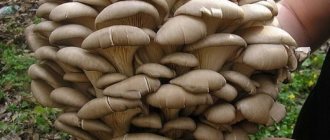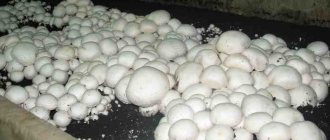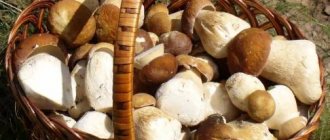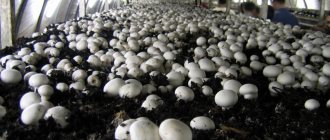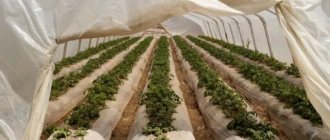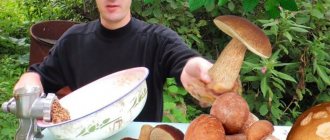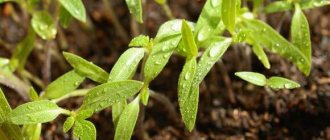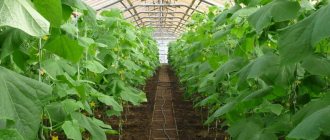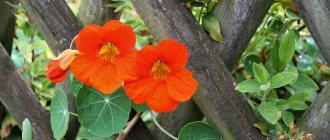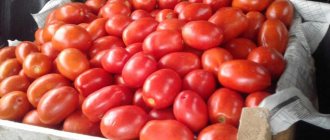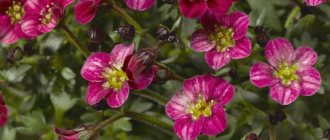Home/Cottage and vegetable garden/Growing champignons in a greenhouse: where they grow, how to grow (technology), what you need, photos, videos
Growing champignons at home is a task that any gardener can do, although growing oyster mushrooms will be a little easier. If you decide to grow champignons yourself in an intensive way, for this you need to choose a cool room, it is best to be a basement or cellar, as it is easier to maintain humidity in them. But at home, if you cannot find such a room, you can grow champignons in a greenhouse.
Gallery: greenhouse for growing mushrooms (25 photos)
Greenhouse construction
The design can be anything, but when choosing the appropriate material for building a greenhouse, it is necessary to take into account all possible loads.
All structural elements must be stable and strong. The greenhouse must be protected from strong winds and be resistant to snow and ice, which must be removed regularly. Materials for frame construction:
- Steel.
- Aluminum.
- Tree.
- Plastics.
Equally important is the choice of suitable facing material. When deciding on a specific type, you should take into account qualities such as durability, low thermal conductivity and, of course, price.
Materials for covering greenhouses.
- Film.
- Mineral glass.
- Polystyrene.
- Polycarbonate sheets.
- Plexiglas.
When creating a large greenhouse, a foundation is required. Concrete is used for the construction of underground elements.
The technology for constructing a greenhouse for mushrooms is almost no different from that used for a vegetable greenhouse. Therefore, you can use any type of greenhouse, covering the part where the mushrooms will be grown from the sun.
Creating optimal conditions
When trying to design a growing area, think about what stimulates mushroom growth in nature. It is high humidity and cool temperature. Two other aspects that are not so obvious are the requirement for high air exchange rates, more specifically the need for low carbon levels and the required level of light. Most mushrooms do not grow well in complete darkness and require a threshold level of light. As for air, high levels of fresh air can be difficult when trying to maintain high humidity, and some experimentation will be required on the part of the home cultivator.
DIY greenhouse made of plastic pipes
Ventilation
The greenhouse must be equipped with ventilation primarily because compost emits gases that inhibit the growth of fungi. It should also be remembered that drafts should not be allowed. If the room is small, then natural ventilation through opening windows, doors or vents is quite sufficient. For large areas, it is necessary to think about automated forced ventilation.
To monitor temperature and humidity, it is best to install a thermometer and hygrometer.
The temperature in the summer season is regulated by ventilation. If you plan to grow mushrooms all year round, then you should take care of additional heating.
Fruiting and harvesting
During the fruiting period, the covering layer must be regularly moistened. It is important that water does not penetrate into the substrate, this will lead to the death of the mycelium.
Harvesting is usually carried out daily. Provided that the mushrooms grow in groups, it is necessary to cut off both large and small ones to ensure further growth of the champignons. The mushrooms are twisted out of the ground, and the vacated areas are sprinkled with a covering mixture.
After the collection is completed, the soil is moistened, the temperature is raised a couple of degrees and the room is ventilated. Keep containers with mycelium away from light.
The second and third waves usually produce the largest amount of harvest.
We suggest you familiarize yourself with How to choose a walk-behind tractor for a summer house and vegetable garden, inexpensive and reliable?
Considering that up to four mushroom harvests can be obtained from one substrate composition, we can say that the labor-intensive process is worth it. Your efforts will not only pay off, but will also bring you a good and stable income.
You can buy champignon myceliums for planting in a greenhouse for sale in our online store.
Recommendations for growing oyster mushrooms and champignons
The temperature during fruiting of the mycelium must be maintained at a level of 14°C. Caring for mushrooms during the fruiting period is similar to the rules for caring for champignons that are grown in racks.
If there is a separate room for growing champignons, then it is more rational to use boxes, since when pasteurizing the compost, you can get several turns of the mushroom during the year.
The structure of good quality mycelium contains thin hyphae in multiple quantities, which give a pleasant smell of the mushroom. The softness of the structure indicates a long stay of the mycelium under production conditions and strong decomposition of the compost. When mycelium is infected with green mold, its color changes, which is reflected in the appearance of the material.
Scheme for preparing a bed in the garden for champignons.
As planting materials, it is better not to use wild mushroom mycelium, which is taken from the place where the mushrooms grow. This will not lead to a normal harvest; it is possible that the mushroom will not grow. Compost production is carried out by farms specializing in mushroom cultivation.
Growing oyster mushrooms extensively allows you to obtain a mushroom harvest without additional operating costs. In this case, the construction of premises for cultivation will not be required. This method involves the purchase of firewood on the basis of collective applications sent by gardening cooperatives to lumber mills.
Planting mushroom plantations in the garden requires their location in fairly shaded areas with a low temperature level. This may be the north side of the building. It is best to cultivate mushrooms in soils that are able to retain moisture best.
You can grow oyster mushrooms on freshly cut stumps with sufficient water content, which will contribute to the normal development of the fungus.
It is best to establish oyster mushroom plantations in forest areas, giving preference to deciduous plantations that have a small area of coniferous trees with obligatory dense undergrowth. Various types of poplar, willow, hornbeam or oak are among the best plant substrates.
Deciduous trees, which have a soft wood type, allow the mycelium of the oyster mushroom to develop faster, although with lower yields than on trees with a hard wood type, which retards the development of the mycelium. You can cultivate oyster mushroom on stumps, freshly cut wood, which contains a sufficient amount of water, which can ensure the normal development of the fungus. The trunk is cut into pieces before inoculation with mycelium begins.
The cultivation of oyster mushroom can also be done on ordinary wood that is damaged by rot. Typically, this type of wood is used as firewood for heating, since it is not used in industry and the national economy. The development of wood-destroying pioneer fungi makes it possible to convert some of the substances that are contained in the cell membrane and are difficult to digest into easily digestible ones. This increases the ability of various types of fungi to produce exoenzymes that are capable of decomposing the polysaccharide complex and lignin. Changes in the structure of wood, for example, increasing the air content, help improve the conditions for the development of fungi.
How to harvest
(adsbygoogle = window.adsbygoogle || []).push({});
The first “fruits” are obtained no earlier than 2 weeks after the mycelium is covered with peat. The yield of champignons is not always uniform; abundant periods can be replaced by a 10-day lull. One harvest period is approximately 6 weeks. The time for picking mushrooms is determined by the condition of the underside of the cap. You can check the maturity of grown champignons by opening the film cover.
The mushroom is not picked, but rather twisted, holding it by the stem. After harvesting, depressions remain and are covered with earth.
Features of cultivation
Oyster mushrooms
How to grow oyster mushrooms in a greenhouse? Oyster mushrooms can be grown in two main ways: on wood blocks or in bags. In the second case, it is necessary to prepare thick bags in advance and fill them with substrate. Fine straw, sawdust or buckwheat husks can be used in this capacity; they can be taken either individually or in mixed form.
You need to add a little mycelium to the substrate, place it in bags and tie them up. Oyster mushroom mycelium grows very quickly, in some cases it even has to be divided.
It is necessary to make 7-10 holes in the bag, from which mushrooms will grow in the future. At the last stage, the bags should be placed suspended on hooks or ropes.
Growing oyster mushrooms in a greenhouse in the second way involves planting mycelium on pieces of wood; for this you will need wooden blocks. Pre-moistened pieces of wood are covered with mycelium, the smallest parts of which penetrate the tree and become fixed in it within a couple of days.
At the next stage, it is necessary to lay roofing felt or plastic film on the area intended for germination, sprinkle it with a mixture of sand, earth and sawdust, lay bars on top every 30 cm. Cover them with earth and small sawdust, sprinkle with manure, lay agrofibre on top.
Popular articles Common spruce Akrokona
Useful video about growing oyster mushrooms:
Champignon
How to grow champignons in a greenhouse? The most important thing when growing champignons is the creation of favorable conditions. The optimal level of air humidity is 75-90%, temperature can fluctuate between 0-25 degrees.
For planting, it is recommended to choose the most hidden areas; the substrate should consist of horse manure and straw.
The technology for growing champignons in a greenhouse is as follows: at the first stage, straw and manure must be placed in piles, sprinkled with ammonium nitrate on top, in the proportion of 4 kg per 1 cubic meter, watered, and left for four days. During this time, the compost warms up, after which it must be dug up and chalk added to the mixture at the rate of 1 kg per 1 cubic meter, after which the substrate is moistened.
Repeated digging is carried out after another four days, for 1 cubic meter. 4 kg of superphosphate and 10 kg of alabaster are added to the mixture. The third digging is carried out after the same period of time, the same substances are added. After this, with a break of four days, four more diggings are carried out without additives; approximately on the 24-25th day, the substrate must be laid out on the beds; the pH of the soil should not deviate much from 7.5.
The resulting mixture must be laid out on beds, in bags or boxes, the depth of the compost is 20 cm, when grown in plastic bags -4 0 cm. An important role when planting mycelium is played by the soil temperature, it should fluctuate in the range of 25-30 degrees (at a depth of 5 cm).
If this condition is not met, the mycelium may not germinate. In the beds, it is necessary to make holes every 25 cm and 8 cm deep; three-centimeter pieces of mycelium should be placed in them; compost and wet newspapers should be placed on top.
In case of high humidity, the mycelium can be scattered over the garden bed; lighting can be minimal. To maintain a humidity level of 85-90%, the floor must be watered periodically.
The first mushrooms appear within two weeks; something like a silvery web forms on the surface. After a mushroom smell appears, the newspapers should be replaced with a special mixture consisting of peat and lime (crumbs) in proportions of 3:1. The layer thickness should be 3-4 cm; light alkaline soil mixtures can also become a peat substitute.
The mycelium is covered with moistened soil, the temperature should be maintained at 14-17 degrees. After another 2-3 weeks you should wait for the first harvest; after a break of 8-10 days, the mycelium begins to bear fruit again.
The crop should be harvested at the stage when the film cover is closed. It is not recommended to grow mushrooms again in the same place; the substrate is used as fertilizer.
Useful video about growing champignons:
Worth noting
It is worth noting that the substrate remaining after growing champignons in a greenhouse cannot under any circumstances be used again! It can become a source of diseases for future mushrooms. This substrate is perfect for growing garden plants.
After collecting mushrooms, champignon greenhouses can be used for growing seedlings or left for summer repairs. Film, glazed or polycarbonate greenhouses can be prepared for planting garden crops.
With the right approach to organizing and using the area of your own plot of land, you can provide yourself with vegetable and mushroom crops all year round.
What should a basement be like for growing mushrooms?
The technology of growing champignons in your own basement involves a certain number of preparatory works. Some people think that for a successful harvest it is enough to plant the mycelium in bags or boxes and leave it under a light bulb. In reality everything is a little more complicated
To successfully grow champignons, you need to focus on the following:
- Ventilation. All varieties of mushrooms, without any exceptions, love fresh air. The problem is that the basement presupposes the presence of damp or rotten air. To keep the walls free from fungus and mold, you need an exhaust hood that will rid the room of bad air and provide fresh air.
Read more: how to properly make a hood in the basement.
Zoning. As mentioned earlier, it is advisable to divide the room into zones, each of which will have its own temperature and lighting. This can be achieved using polyfiber or ordinary plastic partitions, as they retain temperature and moisture well
At this stage, it is very important to correctly determine the area for growing mushrooms if several varieties are expected. Shelving. The optimal material for making a rack is durable plastic.
If wood or metal is used, the temperature environment and humidity will quickly render these materials unusable. Plastic is good because it does not rot or rust. In order not to waste time on making shelving yourself, you can visit a garden center and purchase ready-made elements that you just have to assemble. Lighting. Each type will require individual lighting. If you need to grow several varieties of mushrooms in one room at once, the basement will have to be divided into zones. Since champignons love a lot of light, you need to visit a gardening store and purchase fluorescent lamps for installation in the greenhouse; this will make it possible to regulate the sharpness and brightness of the lighting in the future. Humidity and temperature. The optimal humidity value is considered to be 65-90%. With temperature conditions, things are somewhat more complicated. Champignon can be classified as a heat-loving variety, so the temperature should not be lower than 13 °C and higher than 29 °C. If, simultaneously with champignons, it is necessary to grow oyster mushrooms, which feel best at a temperature of 12...25 ° C, you will have to divide the room into temperature zones. In this case, a water system with a temperature controller is well suited for heating. They are easy to install and economical. Another advantage of such a system is that it does not dry out the air in the basement. Disinfection. To prevent the occurrence of mold, the basement must be disinfected, even before any construction work begins. If the basement is already quite old, it is better to use a formaldehyde solution for spraying. If disinfection is not carried out, mites, fungus flies or nematodes will get on the mushrooms. In this case, you can’t count on a harvest. In the future, a person will have to change the substrate and still disinfect the room, which will entail additional financial costs.
The rest of the equipment includes special containers for placing the substrate, as well as planting myceliums. Also, do not forget that in the future you may need bedding for shelving; they are used in cases where it is difficult to achieve high temperatures in the basement.
It’s also worth taking care of watering. It is worth considering here that watering with a direct stream of water is strictly prohibited, as this will provoke a debate in the substrate, and the mycelium itself may rot or even die. Sometimes people buy lamps that cannot be adjusted, so they shine very brightly. To cope with this problem, you can use a special fabric, which should be installed above the rack so that direct light does not fall on the mushrooms.
Popular articles Planting and caring for Siberian cedar
What you need to know about champignons
The three most common types of this mushroom are cream, brown and white. The latter is of particular interest to us. Yes, it is a little sissy and capricious when it comes to moisture and temperature, but it produces a very high harvest.
For growing, you will need boxes in which it is convenient to place the substrate and mycelium, as well as shelving to save space.
The room should be dark and warm, without drafts.
Comments (8)
Marina
01/18/2020 at 12:34 pm |
We tried growing oyster mushrooms. In principle, it works, but you need to create a certain climate. We grew in the shade of a tree, so we didn’t reap the full harvest, but there was enough for ourselves
Answer
Yulia Expert Plodogorod
01/19/2020 at 21:26 |
Hello, Marina! You are right, cultivating mushrooms requires a certain climate; only shade, and lacy shade, under the canopy of trees is not always enough, especially if the climate is hot.
In the following seasons, we recommend watering the soil in the area where the log houses infected with mycelium are located. And also use a scattering mesh to better shade this place.
We would like to note that such “beds” reach peak fruiting only in the third year after the log houses are infected with mycelium. So, if at first there was no abundance of harvest, this is normal. Since the fruiting bodies have appeared in principle, this indicates that the technology has been followed, which means that the yield will increase in the coming years.
It is important to protect log houses with mycelium from winter frosts. Therefore, we recommend covering the wood with spruce branches, straw or wrapping it in agrofibre.
You can use other materials that allow air to pass through and provide sufficient thermal insulation.
Answer
Julia
01/19/2020 at 16:56 |
We grew champignons on oak stumps for several years in a row. This wood is less susceptible to mold and rot, so mushroom mycelium takes root well. the harvest was good
Answer
Yulia Expert Plodogorod
01/19/2020 at 22:02 |
Hello Julia! Champignons naturally grow on humus-rich soils and like to settle near manure heaps or anthills. Occasionally, such mushrooms can be seen on the dust of dead trees, but not directly on stumps. Perhaps they meant another type of mushroom, oyster mushrooms, which are described in the article?
Yes, oak wood is less susceptible to mold. But this is also one of the varieties of mushrooms. If such a mycelium does not develop well on saw cuts of the specified species, then the mycelium that has been introduced, for example, oyster mushrooms, can also be inhibited by phytoncides contained in oak wood.
Most likely, if we are talking specifically about oyster mushrooms, the planting material was of very good quality, since it not only survived, but also produced a good harvest. In the future, we recommend using hemp from such species as apple, cherry, chestnut, ash, maple, birch, aspen or walnut.
Poplar saw cuts are also suitable, but sometimes mushrooms grown on such wood cause allergic reactions. As for oak, in addition to poor development, the use of such material is fraught with an unpalatable harvest due to the abundance of tannins.
Answer
Julia
01/20/2020 at 07:32 pm |
This is the first time I’ve heard that mold spores are useful for mushroom mycelium. They would simply clog the mycelium and you would get nothing but mold. The best trees for planting are considered to be forest beech, hornbeam, oak, chestnut poplar, ash maple. Poplar is the softest and will fall apart in a couple of years; oak will last longer. We grew it this way, that’s why I wrote about my experience.
Answer
Yulia Expert Plodogorod
01/20/2020 at 08:33 pm |
Hello Julia. It is not recommended to infect the mycelium of edible mushrooms on saw cuts and stumps on which other mycelium is already developing, including mold. The new mycelium will no longer take root. Information that mold spores are beneficial for the growth of other fungi was not provided. Absolutely right, they will not allow other cultures to develop.
Poor mold growth is given as an example and analogy. Phytoncides have a depressing effect on any fungal spores - spontaneously colonized and specially introduced. There was no talk of simultaneous settlement, much less symbiosis.
Moreover, when any mushrooms are cultivated in a special substrate, mold is carefully combated, disinfectants are used, and the affected areas and bars are removed from the mother liquor.
Oak saw cuts for cultivating mushrooms are not recommended for use by all specialists due to the properties of the wood. It has been experimentally established that fruiting bodies grown on oak logs are sometimes bitter, and the development of the mycelium is not as intense as on saw cuts of other tree species.
These advantages, such as resistance to rot and harmful fungi, are indeed characteristic of oak wood. Therefore, all the information provided is advisory in nature and the gardener weighs the pros and cons independently.
Answer
How to care for champignons
- The air temperature in the greenhouse should reach 16 degrees.
- There are also requirements for air humidity. Too dry air will cause the compost to dry out, and humid air will cause the mycelium to rot.
- Watering should be done frequently, but water should be poured little by little. At low temperatures, mushroom growth slows down.
At low temperatures, mushroom growth slows down
Technology for growing champignons in the basement (in bags)
Before you do “mushroom business,” you should find a room for growing champignons. An almost ideal room for growing this crop is a cellar, pantry or closet. It is dark, damp, cool and there are no sudden changes in temperature.
Requirements for the basement:
- floor material - the floor in the cellar should be concrete, not earthen;
- lighting – one light bulb under the ceiling installed for your convenience is enough;
- ventilation - the ventilation system must be well adjusted and actively functioning throughout the entire period of growing champignons. Mushrooms do not grow well in musty rooms with minimal air movement. In addition, the nutrient substrate often releases carbon dioxide, so the champignons practically do not grow. Don't forget to avoid drafts;
- temperature and humidity - for the growth and forcing of mushrooms, the temperature must be maintained at 15-17°C; for this, air conditioners or heating devices should be used. And you can regulate humidity by spraying the floor or shelving with a spray bottle and ventilating.
Those who are seriously involved in growing champignons usually divide the cellar into two parts - for “forcing” the fruiting bodies and for incubating the fruiting bodies on the substrate. But most often, mushrooms are sprouted on racks installed vertically one above the other.
When grown in the basement, you can harvest up to 6-8 waves of harvest
To grow champignons indoors, you can prepare the substrate according to the following recipe:
- horse manure – 2000 kg;
- straw – 50 kg;
- urea – 5 kg;
- ammonium sulfate – 8 kg;
- superphosphate – 5 kg;
- chalk – 7.5 kg.
Soak the straw for a day in warm water in any convenient container. After this, lay it in layers, alternating with horse manure. You should have 6-8 layers. Sprinkle each layer generously with warm water. After 3-4 days, mix the resulting substrate and add a little urea and superphosphate to it. After 3-4 days, re-stir the mass and add minerals again. Repeat this procedure 4-5 times, adding chalk one last time.
Popular articles Polyanthus rose - what is it, types
You can tell that the compost is “ripe” by the light brown color of the manure and the disappearance of the ammonia smell. This usually happens on day 25-30.
After this, you can start growing champignons in bags or on racks. For 1 sq.m of prepared substrate you need to add 500 g of compost mycelium or 400 g of champignon grain spores. Plant the mycelium in holes (up to 5 cm deep) at a distance of 20 cm from each other. Spores can simply be scattered over the surface. During this period, the air humidity in the room should be 75-90%, and the temperature should not be lower than 27°C.
After 10-15 days, mushroom threads will appear on the surface of the substrate. They need to be covered with a mixture of peat, limestone and earth (in a ratio of 5:1:4) and wait another 3-5 days. After this, you should lower the room temperature to 12-17°C and wait for the harvest.
The first mushrooms grow within 3-4 months. They need to be removed while the lower part of the cap is still covered with a whitish film, and the brown plates are not yet visible. Carefully twist out each mushroom, remove it from its place and sprinkle the hole with earth. Fruiting continues for 1-2 weeks.
Where to grow champignons?
First, you need to decide on the place where you will grow mushrooms. And there are a lot of options - these include garden beds, a basement, a cellar, a greenhouse or greenhouse, a shed, and even a glassed-in balcony...
Growing indoors allows you to regulate the growing conditions of champignons. This is a more reliable option that allows you to ensure a stable harvest even out of season or in unfavorable weather conditions.
However, such premises must meet a number of requirements:
- have an area of at least 3 sq.m.,
- ensure good air circulation (but without drafts),
- provide the ability to control temperature and humidity without sudden changes,
- be able to repeatedly withstand chemical or thermal disinfection (concrete, not earthen floor, etc.),
- provide comfortable conditions for work.
Growing mushrooms indoors
Indoors, champignons are most often grown in boxes placed on vertical racks one above the other, although long beds can also be arranged.
After planting the mycelium, the room should be very humid (75-90%) and warm (not lower than 25-27°C) so that the compost does not dry out. If this does happen, cover it with thin burlap or blotting paper and gently moisten it with a spray bottle.
If the process goes well, after 7-14 days white cobwebby mushroom threads will appear - first around the planted mycelium, and then on the surface of the substrate. They need to be covered with a damp mixture of peat, limestone and earth (in a ratio of 5:1:4) and wait another 3-5 days. After this, you should lower the room temperature to 12-17°C and wait for the harvest.
There are other options for the cover mixture, for example, peat and chalk (9:1), garden soil and chalk (97:3).
Light is not important for growing mushrooms. But do not forget to constantly check and regulate the humidity and temperature in the room during the forcing and growth of champignons. To do this, use air conditioners or heating devices, spraying the floor or shelving with a spray bottle, and ventilation.
The first mushrooms grow within 2-3 months after the formation of the mycelium. At first they will grow in “nests” of 5-20 pieces, then the mycelium will spread over the substrate more evenly. You need to remove the mushrooms while the lower part of the cap is still covered with a whitish film, and the brown plates are not yet visible. Carefully twist each mushroom out of its place and sprinkle the hole with the covering mixture.
Fruiting lasts for 1-2 weeks, and in total, when grown in this way, you can collect up to 6-7 waves of harvest (the first 2-3 will be the most productive).
The spent substrate can be used to fertilize the beds, which, however, is not recommended near areas where champignons are grown, because it contains a large number of pathogens of fungal diseases.
Before laying new freshly prepared substrate blocks, the room is washed (if necessary, disinfected with a 2% bleach solution), dried and ventilated well.
Selection of mycelium and preparation of substrate for champignons
The mycelium (mycelium) of champignons should be purchased only from trusted manufacturers - in order to have a guarantee that it will be healthy, sterile and of high quality.
When purchasing mycelium, keep in mind that there are three main varieties of cultivated champignons, which differ in appearance by the color of their caps: white, cream and brown. The first two are usually more productive, but brown champignons are more resistant to temperature/humidity fluctuations and generally to unfavorable environmental conditions.
Mycelium can be grain (sold in plastic bags) and compost (usually in glass jars). The first can be stored for up to six months at a temperature of 0-4°C, the second at the same values for almost a year. Compost mycelium is less productive, but not so sensitive to changes in temperature and humidity.
If you have nowhere to buy mycelium, you can collect it in places where wild champignons grow (you need to take pieces of soil with thin bluish (and therefore young) mycelium, discarding thick yellowish mycelium) or grow it at home yourself. To do this, either fungal spores are sown or isolated from individual pieces of fungal tissue. Wort agar, carrot agar or oat agar are used as a nutrient medium for growing champignons at home.
As for the substrate suitable for champignons, the best option at home would be properly prepared compost based on straw and fresh horse (or, alternatively, cow) manure. As a last resort, manure is replaced with chicken droppings. When preparing this nutrient mixture, it is very important to maintain all proportions and maintain its acidity at a level of 7.3-7.5 pH.
For 100 kg of clean, dry rye or wheat straw without mold, take 40-80 kg of manure, 2 kg of urea, 2 kg of superphosphate, 8 kg of gypsum and 5 kg of chalk. The volume of the substrate prepared from this set of ingredients is precisely designed for the above minimum usable area of 3 sq.m - it will be 200-250 kg.
If bird droppings are used, urea should not be added, because it is initially enriched with nitrogenous compounds.
The composting site must be well ventilated - active heating and ammonia release will occur during the process. It should also be concreted on the floor and protected on top by a canopy - the ripening compost should not be allowed to come into contact with soil or rainwater, because with them, spores of pest fungi can penetrate into the prepared substrate, which will subsequently be very difficult to get rid of.
The straw is soaked in water for 2-3 days (until it starts to “burn”), and then layer-by-layer with manure is folded into a pile. Urea with superphosphate is also added to each layer of wet straw. In the end, there should be at least 3-4 layers of straw and manure each 30-35 cm high.
After laying the pile, you need to water it several times a day - it must remain moist at all times. After a week, the pile is first re-knocked (shaken) - the layers are mixed with a pitchfork, swapping internal and external ones. In total, 4-5 such interruptions should be done with an interval of 3-4 days (not forgetting to moisten the pile during the process). During the penultimate interruption, gypsum and chalk are added to the composition of the prepared substrate (the more, the wetter and heavier the resulting substrate is).
In total, it will take 20-25 days to prepare the substrate. Its readiness can be determined by the disappearance of the ammonia smell and uniform dark brown color. A ripe, high-quality substrate is moist, soft, loose, does not stick to your hands, is slightly springy, and the straw in it breaks easily.
- How to make compost for growing champignons at home
We reveal the secrets of how to make compost for champignons with your own hands.
The finished substrate is laid out in containers (wooden boxes or bags for indoor growing, or half-meter-deep pits lined with polyethylene when growing in the garden) and lightly compacted. After 2-3 days, when the temperature inside the laid compost drops to 23-25°C, you can begin planting the mycelium.
Planting of grain mycelium is carried out by simply spreading it over the surface of the substrate (at the rate of 500 g per 1 sq.m.) and then covering it with a thin layer of compost. Pieces of compost mycelium (the size of a matchbox) are placed in holes at a depth of 4-5 cm in a checkerboard pattern at a distance of 20 cm from each other and are also covered with substrate.
Conditions in premises for growing champignon mushrooms
Premises for growing champignon mushrooms on an industrial scale are special structures: bunkers and tunnels.
A more productive way to make “green” compost is to heat treat it and ferment it in bins. The bunker is a room with an aerated floor, surrounded by three walls. There is no fourth wall, allowing compost to be loaded and unloaded using wheeled vehicles. The necessary conditions for growing champignons are maintained by a high-pressure fan, which pumps air under a pressure of 5000 Pa into a system of pipes equipped with nozzles under the floor of the bunker, and this, in turn, is forced through the nozzles in the floor through the compost layer and aerates it. The diameter of the nozzles is 8 mm, the distance between the nozzles is 40 cm. For 60 tons of compost, placed in a pile 4 m high, you need a bunker with an area of 40 m2. The compost in the bin does not have to be laid in an even layer. There may even be a part of the floor left unfilled with compost, but the compost will still be aerated, because in the underground of even an empty bunker the fan keeps the pressure at least 2500 Pa. To create optimal conditions for growing champignon mushrooms, better aeration of heaps with straw and compost outside the bunker, aerated floors with nozzles are used. An air underground room is built under the required areas of the floor of the composting workshop, into which a high-pressure fan blows air.
The process of processing compost in a bin begins with soaking the straw. Then the compost (a mixture of straw, manure and gypsum) on the aerated floor is watered with recycled water and mixed for 2 days. Then the compost is loaded into a bunker, where it warms up to +80 °C in two days. Unload, mix and re-load into the bunker for 3 days to warm up. Unload onto an aerated floor. The green compost is now ready and can be transported to the tunnel for pasteurization and conditioning.
A tunnel is a narrow and long room for growing mushrooms, where mushroom compost is prepared. Aerobic microorganisms play an important role in this process. The tunnel is designed so that thermophilic aerobic bacteria and actinomycetes develop in the “green” compost loaded there. For this purpose, the tunnel floor is made perforated, and air is pumped into the underground space, which is passed through the compost, creating conditions for aerobic heat-loving bacteria and actinomycetes, which transform “green” compost made in piles or in bins into “brown” compost ready for inoculation with champignon mycelium. compost. From every 3-3.2 tons of “green” compost, 2 tons of “brown” compost are obtained.
Unlike a bunker, the tunnel must be loaded with compost in an even layer so that there are no cracks in the floor uncovered by compost through which air will escape from the underground, causing a drop in pressure there.
Landing rules
Previously, we have already described in general terms how to plant and grow mushrooms in a greenhouse. Today we will talk in detail about the agricultural technology of growing champignons.
The finished compost is laid out in bags or boxes. The temperature inside it should be less than 24 degrees. Each bag should contain approximately 20cm of compost. Mycelium propagation occurs in pieces of mycelium that grew on manure or cereal grains.
The finished compost is laid out in bags or boxes.
Pieces of mycelium grown from manure are the size of table tennis balls. The distance between them reaches 30 cm. The mycelium is buried 3 cm.
The mycelium grown on the grain is scattered over the entire surface of the compost. Then it should be mixed with a 5-centimeter layer of soil. The containers are placed in a warm place. Mushrooms will appear in a week.
Pests
Pests may act in the room where mushrooms are grown.
Ticks enter the mycelium along with manure. The female can lay up to 40 eggs. The insect develops up to a month. Some species feed on mycelium, which significantly reduces the yield. You can recognize that a mite has appeared on mushrooms by the following signs: the cap turns pink, and the stem becomes brown at the base.
The following methods will help prevent the appearance of pests:
- the substrate is kept at a temperature of 55 degrees for 12 hours;
- the soil is disinfected for 8 hours. The temperature should be 60 degrees;
- The rows between the champignons are sprayed with special products.
The most important pest is nematodes. Small worms can spoil the entire mycelium. Threads of mushrooms are pricked onto the nematode's mouth dagger. Pests are very voracious and can destroy the entire crop. Their presence is indicated by a characteristic odor.
You can protect champignons from nematodes as follows: prepare compost in a disinfected place. Manure must be carefully dug up. The cover soil is disinfected. The equipment and premises are also processed after completion of the work.
A dung fly can produce up to 30 eggs. The larvae feast on mushrooms, leaving characteristic marks on the caps and legs. Flies carry various pests - nematodes, mites. Chemical agents will help protect the mycelium.
Flies carry various pests - nematodes, mites - that can ruin the entire mushroom harvest
